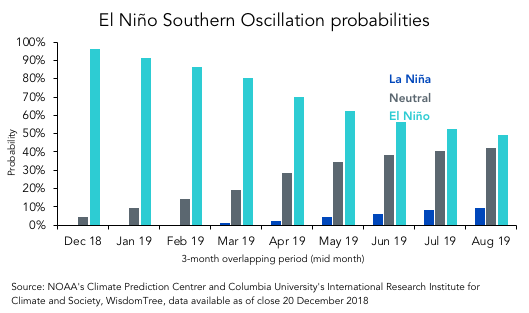Analys
El Niño: the impact on agricultural commodities

 El Niño refers to a climate cycle in the Pacific Ocean that has a global impact on weather patterns. The name, which loosely translates to ‘Christ child’, traces its origin back to Peruvian fisherman in the 1600s, who observed that fish yields would often decline around Christmas time as sea water temperatures rose. The effects of El Niño include specific wind patterns across the Pacific Ocean, heavy rain in South America, and droughts in Australia and parts of Asia including India and Indonesia.
El Niño refers to a climate cycle in the Pacific Ocean that has a global impact on weather patterns. The name, which loosely translates to ‘Christ child’, traces its origin back to Peruvian fisherman in the 1600s, who observed that fish yields would often decline around Christmas time as sea water temperatures rose. The effects of El Niño include specific wind patterns across the Pacific Ocean, heavy rain in South America, and droughts in Australia and parts of Asia including India and Indonesia.
With the National Oceanic and Atmospheric Administration (NOAA) forecasting a 96% probability of an El Niño weather event during the current Northern Hemisphere winter, there is a strong chance that we could see some weather abnormalities in the coming months.
Figure 1. The probability of El Niño occurring this year
Why El Niño matters for agricultural commodity prices
El Niño can have a significant impact on the fortunes of the agricultural industry, as the growing of agricultural products is highly sensitive to weather patterns. The right amount of sun and rain at the right time is important to produce the optimal yield. For example, droughts can ruin a crop because of insufficient water, while floods can wash away plants, or delay the process of harvesting a good crop from the ground, causing it to spoil.
While El Niño can have a considerable effect on agricultural commodity prices, the specific impact on the price of any individual commodity will depend on the El Niño’s amplitude and timing, as well as locational factors such as where the crop is grown and how prepared the farmers are for extreme conditions.
Figure 2. Weather impact of El Niño
Analysing the impact on agricultural commodity prices
When assessing likely El Niño effects, the first step is to consider the time of the year that El Niño is likely to begin. In this case, the NOAA believes that the event is likely to arrive in the Northern Hemisphere winter this year, but there is a good chance that it could linger into the Northern Hemisphere summer with a lower intensity. The next step is to assess which part of the crop cycle it will affect. According to research by Iizumi et al., a weather disturbance during the ‘reproductive’ growth period of the crop cycle tends to have the largest impact on crop yields.
Using insights from Iizumi et al. we have assessed the possible near-term impact from an El Niño on crops that are in the reproductive phase of growth. We summarise our key thoughts below:
Bullish on sugar, cocoa, and wheat
Agricultural commodities that we are bullish on in the event of an El Niño include sugar, cocoa, and wheat.
Sugar production is highly concentrated in India and certain regions of Brazil. If El Niño occurs, it’s likely that both countries could see below-average rainfall and drier conditions, and this could drive prices higher.
Indonesia, which produces 10% of global cocoa supply, could also be directly affected by an El Niño, and dry warm weather in Indonesia could potentially drive cocoa prices higher.
Australia, which produces 4% of global wheat supply, is another country that could face dry weather if El Niño emerges. This could have a positive impact on wheat prices, although much of the wheat harvest is expected to be completed by mid-January, which should limit the impact of an El Niño.
Bearish on soybean, corn and Arabica coffee
In contrast, we are bearish on soybean, corn, and Arabica coffee.
Brazil and Argentina, who together are responsible for almost half of the world’s soybean supply, are likely to experience favourable growing conditions in the event of an El Niño. As such, an El Niño could prove to be price negative for soybean prices.
Figure 3. The effect of El Niño on soybean growing during the December to March reproductive growth phase
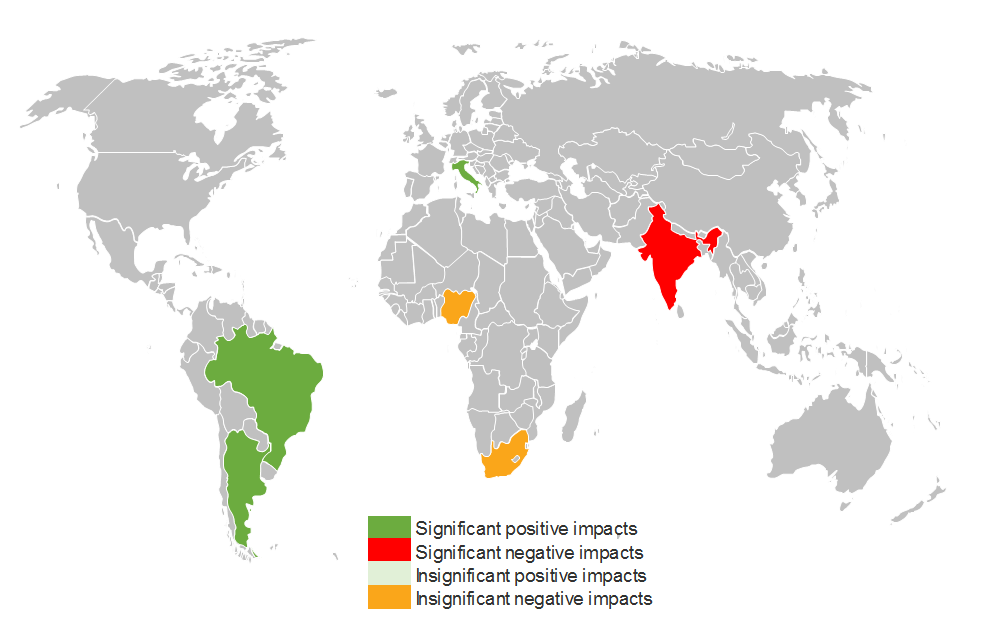
Source: Adapted by WisdomTree from “Impacts of Southern Oscillation on the global yields of major crops” by Iizumi et al, May 2014
The effects of El Niño on corn are less significant, but could be mildly positive for growing conditions in South America and parts of Australia, and hence slightly price bearish.
Arabica coffee production is highly concentrated in Brazil, Mexico, Colombia and Central America. These countries could experience favourable growing conditions, and given that most of the coffee in these regions will be in a reproductive growth phase in the months ahead, we could see a positive supply shock to the commodity, which would be bearish for prices.
Other factors
We caution that the analysis above is based on the pure effect of an El Niño event and does not consider the many other factors that can impact crop yields. We’ll also point out that agricultural commodity prices can be affected by a number of other developments such as exchange-rate movements and trade policies. However, the analysis is useful as a rough guide as to how commodity prices could potentially be affected if we do experience an El Niño event in the near term.
Analys
Also OPEC+ wants to get compensation for inflation

Brent crude has fallen USD 3/b since the peak of Iran-Israel concerns last week. Still lots of talk about significant Mid-East risk premium in the current oil price. But OPEC+ is in no way anywhere close to loosing control of the oil market. Thus what will really matter is what OPEC+ decides to do in June with respect to production in Q3-24 and the market knows this very well. Saudi Arabia’s social cost-break-even is estimated at USD 100/b today. Also Saudi Arabia’s purse is hurt by 21% US inflation since Jan 2020. Saudi needs more money to make ends meet. Why shouldn’t they get a higher nominal pay as everyone else. Saudi will ask for it

Brent is down USD 3/b vs. last week as the immediate risk for Iran-Israel has faded. But risk is far from over says experts. The Brent crude oil price has fallen 3% to now USD 87.3/b since it became clear that Israel was willing to restrain itself with only a muted counter attack versus Israel while Iran at the same time totally played down the counterattack by Israel. The hope now is of course that that was the end of it. The real fear has now receded for the scenario where Israeli and Iranian exchanges of rockets and drones would escalate to a point where also the US is dragged into it with Mid East oil supply being hurt in the end. Not everyone are as optimistic. Professor Meir Javedanfar who teaches Iranian-Israeli studies in Israel instead judges that ”this is just the beginning” and that they sooner or later will confront each other again according to NYT. While the the tension between Iran and Israel has faded significantly, the pain and anger spiraling out of destruction of Gaza will however close to guarantee that bombs and military strifes will take place left, right and center in the Middle East going forward.
Also OPEC+ wants to get paid. At the start of 2020 the 20 year inflation adjusted average Brent crude price stood at USD 76.6/b. If we keep the averaging period fixed and move forward till today that inflation adjusted average has risen to USD 92.5/b. So when OPEC looks in its purse and income stream it today needs a 21% higher oil price than in January 2020 in order to make ends meet and OPEC(+) is working hard to get it.
Much talk about Mid-East risk premium of USD 5-10-25/b. But OPEC+ is in control so why does it matter. There is much talk these days that there is a significant risk premium in Brent crude these days and that it could evaporate if the erratic state of the Middle East as well as Ukraine/Russia settles down. With the latest gains in US oil inventories one could maybe argue that there is a USD 5/b risk premium versus total US commercial crude and product inventories in the Brent crude oil price today. But what really matters for the oil price is what OPEC+ decides to do in June with respect to Q3-24 production. We are in no doubt that the group will steer this market to where they want it also in Q3-24. If there is a little bit too much oil in the market versus demand then they will trim supply accordingly.
Also OPEC+ wants to make ends meet. The 20-year real average Brent price from 2000 to 2019 stood at USD 76.6/b in Jan 2020. That same averaging period is today at USD 92.5/b in today’s money value. OPEC+ needs a higher nominal price to make ends meet and they will work hard to get it.
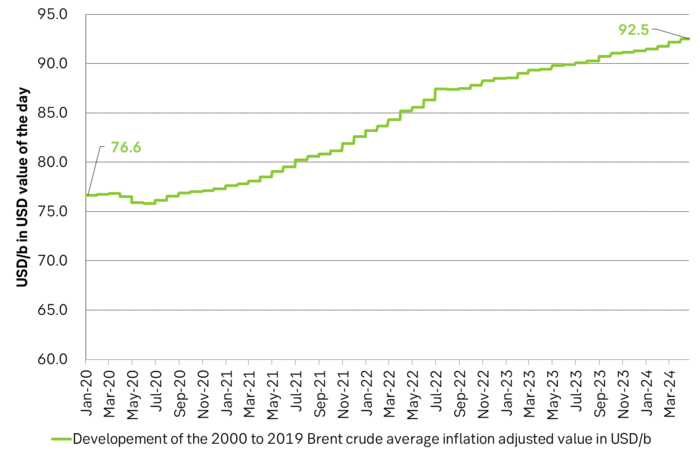
Inflation adjusted Brent crude price versus total US commercial crude and product stocks. A bit above the regression line. Maybe USD 5/b risk premium. But type of inventories matter. Latest big gains were in Propane and Other oils and not so much in crude and products
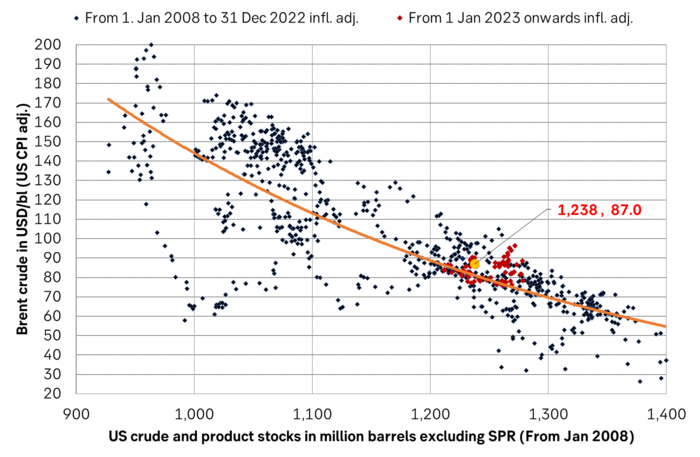
Total US commercial crude and product stocks usually rise by 4-5 m b per week this time of year. Gains have been very strong lately, but mostly in Propane and Other oils

Last week’s US inventory data. Big rise of 10 m b in commercial inventories. What really stands out is the big gains in Propane and Other oils
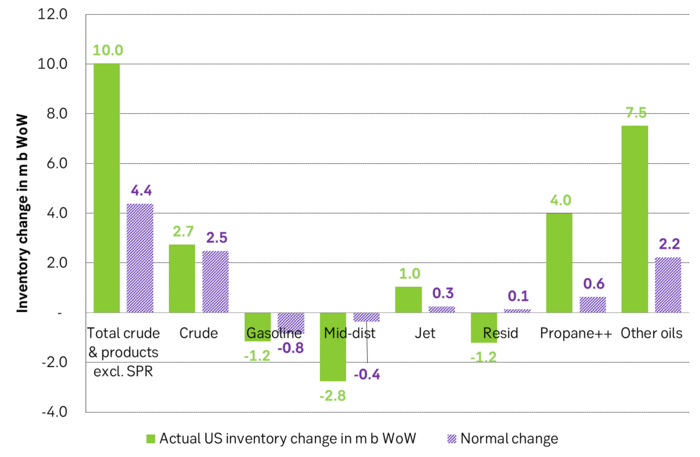
Take actual changes minus normal seasonal changes we find that US commercial crude and regular products like diesel, gasoline, jet and bunker oil actually fell 3 m b versus normal change.
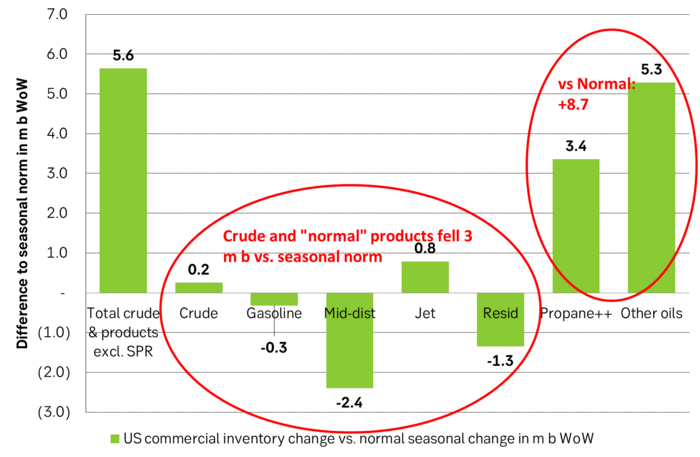
Analys
Nat gas to EUA correlation will likely switch to negative in 2026/27 onward

Historically positive Nat gas to EUA correlation will likely switch to negative in 2026/27 onward

Historically there has been a strong, positive correlation between EUAs and nat gas prices. That correlation is still fully intact and possibly even stronger than ever as traders increasingly takes this correlation as a given with possible amplification through trading action.
The correlation broke down in 2022 as nat gas prices went ballistic but overall the relationship has been very strong for quite a few years.
The correlation between nat gas and EUAs should be positive as long as there is a dynamical mix of coal and gas in EU power sector and the EUA market is neither too tight nor too weak:
Nat gas price UP => ”you go black” by using more coal => higher emissions => EUA price UP
But in the future we’ll go beyond the dynamically capacity to flex between nat gas and coal. As the EUA price moves yet higher along with a tightening carbon market the dynamical coal to gas flex will max out. The EUA price will then trade significantly above where this flex technically will occur. There will still be quite a few coal fired power plants running since they are needed for grid stability and supply amid constrained local grids.
As it looks now we still have such overall coal to gas flex in 2024 and partially in 2025, but come 2026 it could be all maxed out. At least if we look at implied pricing on the forward curves where the forward EUA price for 2026 and 2027 are trading way above technical coal to gas differentials. The current forward pricing implications matches well with what we theoretically expect to see as the EUA market gets tighter and marginal abatement moves from the power sector to the industrial sector. The EUA price should then trade up and way above the technical coal to gas differentials. That is also what we see in current forward prices for 2026 and 2027.
The correlation between nat gas and EUAs should then (2026/27 onward) switch from positive to negative. What is left of coal in the power mix will then no longer be dynamically involved versus nat gas and EUAs. The overall power price will then be ruled by EUA prices, nat gas prices and renewable penetration. There will be pockets with high cost power in the geographical points where there are no other alternatives than coal.
The EUA price is an added cost of energy as long as we consume fossil energy. Thus both today and in future years we’ll have the following as long as we consume fossil energy:
EUA price UP => Pain for consumers of energy => lower energy consumption, faster implementation of energy efficiency and renewable energy => lower emissions
The whole idea with the EUA price is after all that emissions goes down when the EUA price goes up. Either due to reduced energy consumption directly, accelerated energy efficiency measures or faster switch to renewable energy etc.
Let’s say that the coal to gas flex is maxed out with an EUA price way above the technical coal to gas differentials in 2026/27 and later. If the nat gas price then goes up it will no longer be an option to ”go black” and use more coal as the distance to that is too far away price vise due to a tight carbon market and a high EUA price. We’ll then instead have that:
Nat gas higher => higher energy costs with pain for consumers => weaker nat gas / energy demand & stronger drive for energy efficiency implementation & stronger drive for more non-fossil energy => lower emissions => EUA price lower
And if nat gas prices goes down it will give an incentive to consume more nat gas and thus emit more CO2:
Cheaper nat gas => Cheaper energy costs altogether, higher energy and nat gas consumption, less energy efficiency implementations in the broader economy => emissions either goes up or falls slower than before => EUA price UP
Historical and current positive correlation between nat gas and EUA prices should thus not at all be taken for granted for ever and we do expect this correlation to switch to negative some time in 2026/27.
In the UK there is hardly any coal left at all in the power mix. There is thus no option to ”go black” and burn more coal if the nat gas price goes up. A higher nat gas price will instead inflict pain on consumers of energy and lead to lower energy consumption, lower nat gas consumption and lower emissions on the margin. There is still some positive correlation left between nat gas and UKAs but it is very weak and it could relate to correlations between power prices in the UK and the continent as well as some correlations between UKAs and EUAs.
Correlation of daily changes in front month EUA prices and front-year TTF nat gas prices, 250dma correlation.
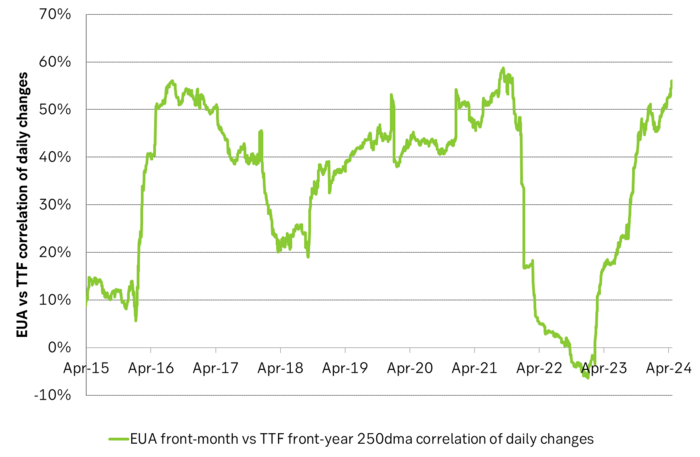
EUA price vs front-year TTF nat gas price since March 2023
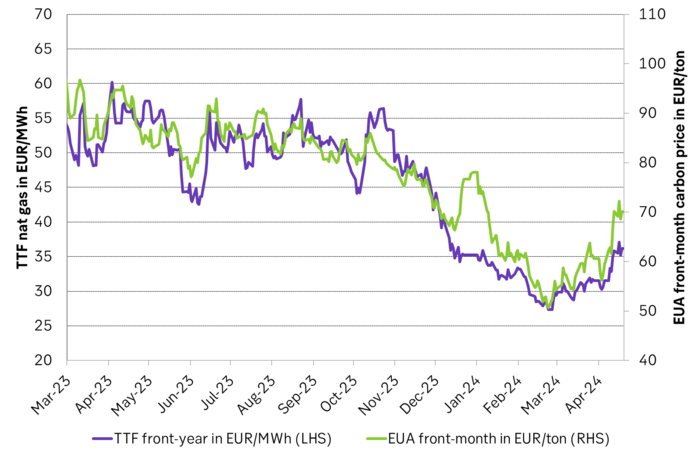
Front-month EUA price vs regression function of EUA price vs. nat gas derived from data from Apr to Nov last year.
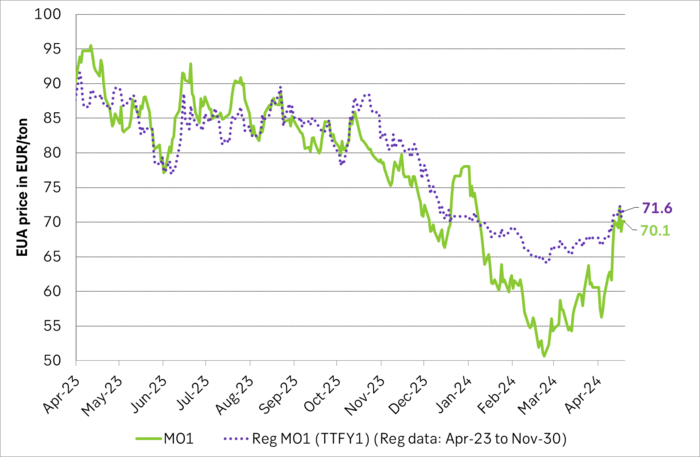
The EUA price vs the UKA price. Correlations previously, but not much any more.
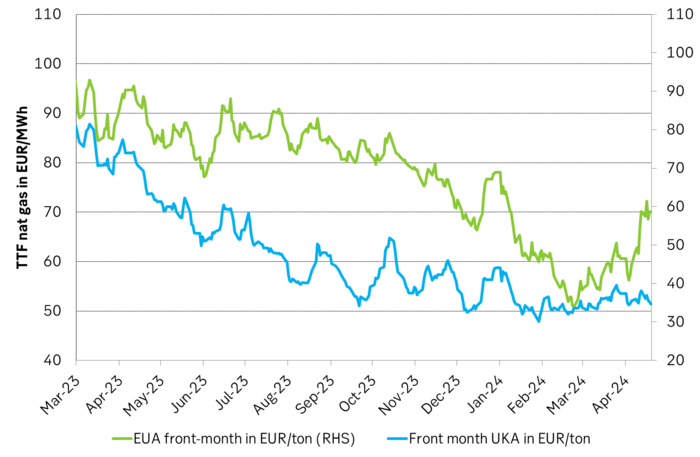
Forward German power prices versus clean cost of coal and clean cost of gas power. Coal is totally priced out vs power and nat gas on a forward 2026/27 basis.
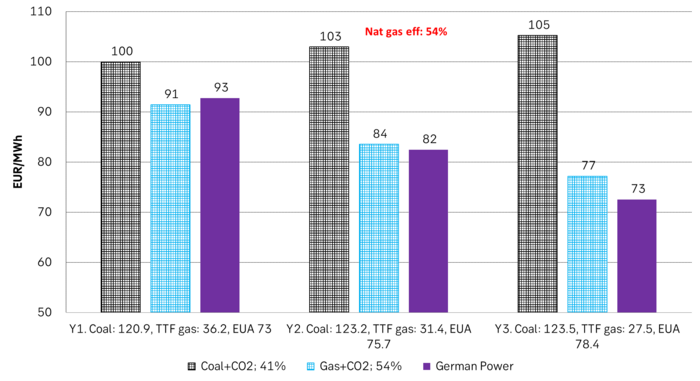
Forward price of EUAs versus technical level where dynamical coal to gas flex typically takes place. EUA price for 2026/27 is at a level where there is no longer any price dynamical interaction or flex between coal and nat gas. The EUA price should/could then start to be negatively correlated to nat gas.

Forward EAU price vs. BNEF base model run (look for new update will come in late April), SEB’s EUA price forecast.
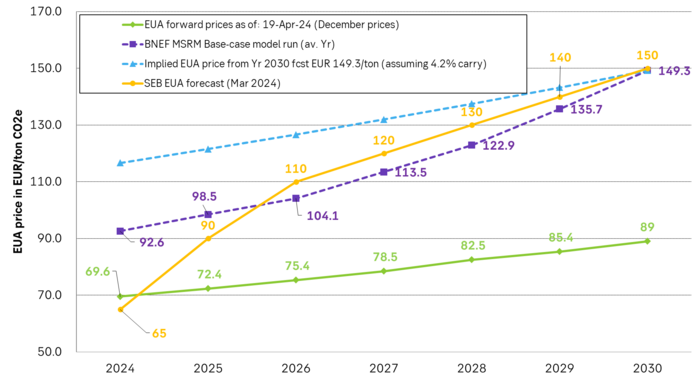
Analys
Fear that retaliations will escalate but hopes that they are fading in magnitude

Brent crude spikes to USD 90.75/b before falling back as Iran plays it down. Brent crude fell sharply on Wednesday following fairly bearish US oil inventory data and yesterday it fell all the way to USD 86.09/b before a close of USD 87.11/b. Quite close to where Brent traded before the 1 April attack. This morning Brent spiked back up to USD 90.75/b (+4%) on news of Israeli retaliatory attack on Iran. Since then it has quickly fallen back to USD 88.2/b, up only 1.3% vs. ydy close.

The fear is that we are on an escalating tit-for-tat retaliatory path. Following explosions in Iran this morning the immediate fear was that we now are on a tit-for-tat escalating retaliatory path which in the could end up in an uncontrollable war where the US unwillingly is pulled into an armed conflict with Iran. Iran has however largely diffused this fear as it has played down the whole thing thus signalling that the risk for yet another leg higher in retaliatory strikes from Iran towards Israel appears low.
The hope is that the retaliatory strikes will be fading in magnitude and then fizzle out. What we can hope for is that the current tit-for-tat retaliatory strikes are fading in magnitude rather than rising in magnitude. Yes, Iran may retaliate to what Israel did this morning, but the hope if it does is that it is of fading magnitude rather than escalating magnitude.
Israel is playing with ”US house money”. What is very clear is that neither the US nor Iran want to end up in an armed conflict with each other. The US concern is that it involuntary is dragged backwards into such a conflict if Israel cannot control itself. As one US official put it: ”Israel is playing with (US) house money”. One can only imagine how US diplomatic phone lines currently are running red-hot with frenetic diplomatic efforts to try to defuse the situation.
It will likely go well as neither the US nor Iran wants to end up in a military conflict with each other. The underlying position is that both the US and Iran seems to detest the though of getting involved in a direct military conflict with each other and that the US is doing its utmost to hold back Israel. This is probably going a long way to convince the market that this situation is not going to fully blow up.
The oil market is nonetheless concerned as there is too much oil supply at stake. The oil market is however still naturally concerned and uncomfortable about the whole situation as there is so much oil supply at stake if the situation actually did blow up. Reports of traders buying far out of the money call options is a witness of that.
-

 Nyheter3 veckor sedan
Nyheter3 veckor sedanGuldpriset når nytt all time high och bryter igenom 2300 USD
-

 Nyheter4 veckor sedan
Nyheter4 veckor sedanLundin Mining får köprekommendation av BMO
-

 Nyheter2 veckor sedan
Nyheter2 veckor sedanUSAs stigande konsumtion av naturgas
-

 Nyheter3 veckor sedan
Nyheter3 veckor sedanCentralbanker fortsatte att köpa guld under februari
-

 Nyheter3 veckor sedan
Nyheter3 veckor sedanKakaomarknaden är extrem för tillfället
-

 Nyheter3 veckor sedan
Nyheter3 veckor sedanHur mår den svenska skogsbraschen? Två favoritaktier
-

 Nyheter4 veckor sedan
Nyheter4 veckor sedanBoliden på 20 minuter
-

 Nyheter3 veckor sedan
Nyheter3 veckor sedanBetydande underskott i utbudet av olja kan få priset att blossa upp


